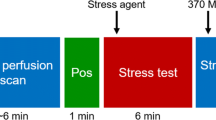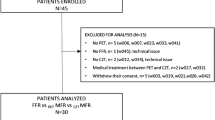Abstract
Background
PET/CT is the standard for quantitative assessments of myocardial blood flow (MBF), but it requires short-lived-tracers, costly, and not widely available. SPECT with Cadmium Zinc Telluride (CZT) detectors allows dynamic acquisition and quantitation of MBF. The study aims were to compare MBF measurements by 99mTc-tetrofosmin-CZT to N13NH3 PET/CT after regadenoson-induced coronary hyperemia and to evaluate the effect of attenuation correction (AC).
Methods
54 patients were evaluated at rest and during vasodilation by 99mTc-tetrofosmin-CZT and N13NH3 PET/CT within 2 weeks. MBF and MBF reserve (MFR) were measured by CZT with or without AC (NAC).
Results
The global rest MBF was 0.76 ± 0.19 mL/min/gr by PET and 0.76 ± 0.24 by AC-CZT (P = NS) and 1.14 ± 0.4 by NAC-CZT (P < 0.001 vs PET and AC-CZT). Stress MBF was higher when measured by PET than AC-CZT (1.87 ± 0.45 vs 1.62 ± 0.68 mL/min/gr, P < 0.0008), but lower than NAC-CZT (2.36 ± 1.1, P < 0.0003). The MBF reserve ratio (MFR) was higher by PET than AC-CZT (2.52 ± 0.56 vs 2.22 ± 1 (P < 0.009) and NAC-CZT (2.18 ± 1.0, P < 0.004). Linear regression was better between PET (MFR and stress MBF) and AC-CZT than between PET and NAC-CZT. ROC curve analysis showed the significant ability of AC-CZT to predict MFR < 2 and stress MBF < 1.7 (AUC = 0.75 and 0.82 respectively) and to differentiate between normal and CAD patients (AUC = 0.747 and 0.892 for MFR and stress MBF, respectively).
Conclusions
Our data show a reasonable correlation between MBF and MFR measured by N13NH3-PET and 99mTc-Tetrofosmin-CZT SPECT. NAC-CZT overestimates MBF. AC is recommended when using CZT for measuring MBF.














Similar content being viewed by others
Abbreviations
- CZT:
-
Cadmium-zinc-telluride single photon emission tomography
- PE:
-
Positron emission tomography
- CT:
-
Computed tomography
- MPI:
-
Myocardial perfusion imaging
- MBF:
-
Myocardial blood flow
- MFR:
-
Myocardial blood flow reserve
- AC:
-
Attenuation correction
- NAC:
-
Non attenuation correction
- MI:
-
Myocardial infarction
- CAD:
-
Coronary artery disease
- CABG:
-
Coronary artery bypass graft
- PCI:
-
Percutaneous coronary intervention
- TAC:
-
Time activity curve
- AUC:
-
Area under the ROC curve
- N13NH3 :
-
N13-ammonia
References
Sara JD, Widmer RJ, Matsuzawa Y, et al. Prevalence of coronary microvascular dysfunction among patients with chest pain and non obstructive coronary artery disease. JACC Cardiovasc Interv 2015;8:1445-53.
Motwani M, Motlagh M, Gupta A, et al. Reasons and implications of agreements and disagreements between coronary flow reserve, fractional flow reserve, and myocardial perfusion imaging. J Nucl Cardiol 2018;25:104-19.
Lee JM, Jung JH, Hwang D, et al. Coronary flow reserve and microcirculatory resistance in patients with intermediate coronary stenosis. J Am Coll Cardiol 2016;67:1158-69.
Schindler TH, Schelbert HR, Quercioli A, Dilsizian V. Cardiac PET imaging for the detection and monitoring of coronary artery disease and microvascular health. JACC Cardiovasc Imaging 2010;3:623-40.
Brainin P, Frestad D, Prescott E. The prognostic value of coronary endothelial and microvascular dysfunction in subjects with normal or non-obstructive coronaryartery disease: A systematic review and meta-analysis. Int J Cardiol 2018;1:1-9.
Agostini D, Roule V, Nganoa C, et al. First validation of myocardial flow reserve assessed by dynamic (99m)Tc-sestamibi CZT-SPECT camera: head to head comparison with (15)O-water PET and fractional flow reserve in patients with suspected coronary artery disease. The WATERDAY study. Eur J Nucl Med Mol Imaging 2018;45(7):1079-90.
Miyagawa M, Nishiyama Y, Uetani T, et al. Estimation of myocardial flow reserve utilizing an ultrafast cardiac SPECT: Comparison with coronary angiography, fractional flow reserve, and the SYNTAX score. Int J Cardiol 2017;1:347-53.
Nkoulou R, Fuchs TA, Pazhenkottil AP, et al. Absolute myocardial bloodflow and flow reserve assessed by gated SPECT with cadmium-zinc-telluride detectors using 99mTc-Tetrofosmin: Head-to-Head comparison with 13N-Ammonia PET. J Nucl Med 2016;57:1887-92.
Fang YD, Liu YC, Ho KC, et al. Single-scan rest/stress imaging with 99mTc-Sestamibi and cadmium zinc telluride-based SPECT for hyperemic flow quantification: A feasibility study evaluated with cardiac magnetic resonance imaging. PLoS ONE 2017;12:e0183402.
Zavadovsky KV, Mochula AV, Boshchenko AA, et al. Absolute myocardial blood flows derived by dynamic CZT scan vs invasive fractional flow reserve: Correlation and accuracy. J Nucl Cardiol 2019. https://doi.org/10.1007/s12350-019-01678-z.
Nagamachi S, Czernin J, Kim AS, et al. Reproducibility of measurements of regional resting and hyperemic myocardial blood flow assessed with PET. J Nucl Med 1996;37:1626-31.
Chareonthaitawee P, Kaufmann PA, Rimoldi O, Camici PG. Heterogeneity of resting and hyperemic myocardial blood flow in healthy humans. Cardiovasc Res 2001;50:151-61.
Leppo JA, Meerdink DJ. Comparison of the myocardial uptake of a technetium-labeled isonitrile analogue and thallium. Circ Res 1989;65:632-9.
Zoccarato O, Lizio D, Savi A, et al. Comparative analysis of cadmium-zincum-telluride cameras dedicated to myocardial perfusion SPECT: A phantom study. J Nucl Cardiol 2016;23:885-93.
Tsuchida T, Yonekura Y, Takahashi N, et al. A trial for the quantification of regional myocardial blood flow with continuous infusion of Tc-99m MIBI and dynamic SPECT. Ann Nucl Med 1999;13:61-4.
Klein R, Beanlands RS, deKemp RA. Quantification of myocardial blood flow and flow reserve: Technical aspects. J Nucl Cardiol 2010;17:555-70.
Statuto M, Galli E, Bertagna F, Migliorati E, et al. The strange case of the [13N]NH3: Validation of the production process for human use. Nucl Med Commun 2016;37:412-21.
Murthy VL, Bateman TM, Beanlands RS, Berman DS, Borges-Neto S, Chareonthaitawee P, Cerqueira MD, deKemp RA, DePuey EG, Dilsizian V, et al. Clinical quantification of myocardial blood flow using PET: Joint position paper of the SNMMI cardiovascular council and the ASNC. J Nucl Cardiol 2018;25:269-97.
Bauckneht M, Piva R, Ferrarazzo G, et al. Non-invasive measurement of coronary flow reserve: Uniqueness of radionuclide methods and alternative techniques. Q J Nucl Med Mol Imaging 2016;60:324-37.
Gupta A, Taqueti VR, van de Hoef TP, et al. Circulation 2017;136:2325-36.
Wells RG, Marvin B, Poirier M, et al. Optimization of SPECT measurement of myocardial blood flow with corrections for attenuation, motion, and blood binding compared with PET. J Nucl Med 2017;58:2013-9.
Gimelli A, Bottai M, Giorgetti A, et al. Evaluation of ischaemia in obese patients: Feasibility and accuracy of a low-doseprotocol with a cadmium-zinc telluride camera. Eur J Nucl Med Mol Imaging 2012;39:1254-61.
Disclosures
Raffaele Giubbini, Mattia Bonacina, Rexhep Durmo, Domenico Albano, Pompilio Faggiano, Elisa Milan, Francesco Bertagna, Carlo Rodella, Barbara Paghera, Marina Gazzilli, Elisabetta Cerudelli, Francesco Bertagna, and Luca Camoni declare that they do not have conflicts of interest concerning this paper. Eli Stern is a research manager of GE Healthcare, Haifa, Israel.
Author information
Authors and Affiliations
Corresponding author
Additional information
Publisher's Note
Springer Nature remains neutral with regard to jurisdictional claims in published maps and institutional affiliations.
The authors of this article have provided a PowerPoint file, available for download at SpringerLink, which summarizes the contents of the paper and is free for re-use at meetings and presentations. Search for the article DOI on SpringerLink.com.
The authors have also provided an audio summary of the article, which is available to download as ESM, or to listen to via the JNC/ASNC Podcast.
Electronic supplementary material
Below is the link to the electronic supplementary material.
Rights and permissions
About this article
Cite this article
Giubbini, R., Bertoli, M., Durmo, R. et al. Comparison between N13NH3-PET and 99mTc-Tetrofosmin-CZT SPECT in the evaluation of absolute myocardial blood flow and flow reserve. J. Nucl. Cardiol. 28, 1906–1918 (2021). https://doi.org/10.1007/s12350-019-01939-x
Received:
Accepted:
Published:
Issue Date:
DOI: https://doi.org/10.1007/s12350-019-01939-x




